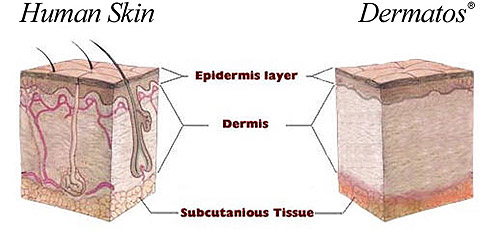Alatheia markets several prosthetic technologies for amputees throughout the world, but among the most widely known is the highly functional Dermatos prosthesis line. The Dermatos name is used to indicate that these products are made to look like skin, whether finger, hand or foot prosthetics. Dermatos prosthetic devices and prosthetic skin are specifically designed for each amputee’s functional needs.
Custom sculpting gives each prosthesis elements of character that help it to “blend in.” Each finger is precisely shaped, the lines under the knuckle are replicated, and fingerprints go all the way down (not just the tips). Crafted fingernails are natural to the individual and give our prosthesis its special “signature.”
A finger usually has color variation throughout its length. Whether this means a rosier color tone towards the tips, or a blotchy look to the palm-side skin, each finger is detailed and unique. Alatheia’s attention to detail in painting colors lets your prosthesis reflect these features.
Alatheia utilizes custom fitting for efficient function and necessary protection. The inside of the prosthesis is created to fit directly onto a specific and individual residuum. This will help the prosthesis stay on properly, and will also protect the flesh underneath even as it helps to restore the finger’s function.
Prostheses made with inexpensive silicone will tear and quickly be rendered useless. Alatheia Prostheses are created out of medical grade silicone, which is stronger and prevents the skin from becoming irritated. This also allows the prosthesis to be stable in shape and size. The silicone is painted from the inside to reduce wear and tear.
In real human skin, the epidermis layer (the outer layer of skin) has fingerprints and skin detail; it also contains pigment called melanin. When skin is exposed to the sun, more melanin is created to help counteract the damaging rays of the sun. Likewise, the epidermis of the prosthesis skin layer contains remarkably realistic fingerprints and skin detail along with a simulated melanin. Furthermore, when an amputee wearing our prosthesis gets a tan on their real skin, they are supplied with “prosthetic melanin” in a bottle so the prosthesis can be made to match their new tan. Each user is able to apply this “liquid tan” directly on their prosthesis where it is absorbed immediately into the epidermis layer. The tanning liquid will fade much like a real tan.
Alatheia takes this same attention to detail with the other layers of skin. In real human skin, the layer of skin below the epidermis, known as the dermis, is a translucent mesh of skin cells with little or no pigment, allowing the color from the subcutaneous layer to be seen. The dermis layer is visually identical. And while the deepest human skin layer, the subcutaneous layer, contains blood vessels and subcutaneous fat that creates the final element of skin color, we mimic these hues with a custom painted translucent layer of pigmented silicone.
